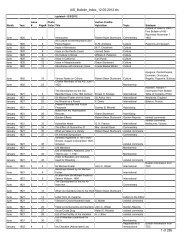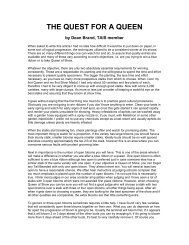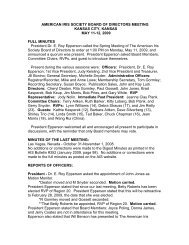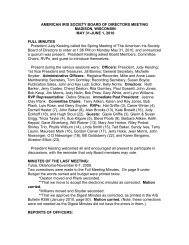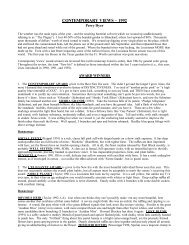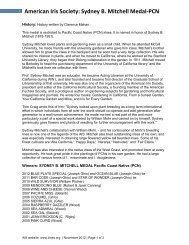contemporary views – 1988 award winners - American Iris Society
contemporary views – 1988 award winners - American Iris Society
contemporary views – 1988 award winners - American Iris Society
Create successful ePaper yourself
Turn your PDF publications into a flip-book with our unique Google optimized e-Paper software.
introduction to date, and feel it is one of the cleanest, smoothest true deep yellow selfs on the market. It too should be<br />
useful in red-bearded yellow breeding. A sleeper for me has been FIRST IMPRESSION (Gatty 1985), an early-blooming<br />
ivory-cream that has substance like wax. Show stalks supreme, and doesn’t seem susceptible to late freezes as so many<br />
early-blooming, tender varieties are here. It is sad that many of Nate Rudolph’s last introductions (that he selected) didn’t<br />
receive the distribution and acclaim that those earlier releases such as ‘Pink Taffeta’ and ‘Lemon Mist’ garnered.<br />
YELLOW FLOUNCE (1984) is a broad, full-blown lemon-yellow reverse amoena with tight lace. The tone is different<br />
from others <strong>–</strong> not dirty or smoky, yet has undertonings that give a totally different visual impact. Minimally acceptable<br />
bud count (6 to 7), but displayed on well spaced, well placed branching.<br />
CLASSICS: DREAM AFFAIR (Gatty 1978); EASTERTIME (Schreiner 1980); GOLD GALORE (Schreiner 1978).<br />
PLICATAS:<br />
Some of the most exciting work is being done here <strong>–</strong> with all kinds of crazy color combinations and types of patterning.<br />
Contrasting, never-seen-before-on-plicatas beards just further whet the appetite. But in many of the bloodlines, significant<br />
defects such as tender growth, susceptibility to soft rot, and erratic growth habits must be acknowledged by the serious<br />
plicata hybridizer, or this creative work will be all for naught. Fortunately, I am beginning to see evidence that some<br />
hybridizers are undertaking this mammoth task of correcting the problems. The first 3 listed are my proof: Keppel’s blue<br />
plic line seems to be the healthiest of the West Coast lines, and SNOWBROOK (1987) is his best offering. It is certainly<br />
his most beautiful. Pure icy white standards top falls that are only finely edged with the purest blue seen to date in<br />
plicatas, with a deeper, heavier concentration of blue in the shoulders. Incredible branching and bud count, as Keith has<br />
become famous for. An absolute vision of health, with strong, full-fanned plants loaded with increase. Contemporary<br />
Award runnerup RASPBERRY FUDGE (Keppel 1989) is thusfar the healthiest and strongest from the Gibson bloodlines.<br />
And the 9-1-1 Award winner, TIDE MARK (Hummel 1987) gives the most promise, for, keep in mind that it is from a<br />
totally different approach to plicatas that originated in a cold weather climate (from Moldovan’s recessive plicata, ‘Guardian<br />
Gate’). This one, combined with West Coast bloodlines, will produce the elusive red-bearded blue plicata, I predict.<br />
JITTERBUG (Keppel <strong>1988</strong>) is a sizzling bright gold, with the falls precisely sanded, stitched, and peppered deep<br />
cinnamon brown. Basically an improved, taller, brighter version of this year’s AM winner, ‘Wild Jasmine’ (Hamner), but<br />
the marking is more distinctive. For me, ‘Jitterbug’ has had exceptional growth habits. Another razzle-dazzle plicata is<br />
HOT STREAK (Ghio <strong>1988</strong>), a tall, imposing child of ‘Gigolo’ (Keppel), with pure deep gold standards atop white and<br />
gold blended falls that are boldly, irregularly patterned in red. Branching and bud count are good, but growth habits need<br />
to be further tested here in the Midwest. Jim Gibson’s most overlooked later plicata release is MOUNTAIN MELODY<br />
(1984), a unique blending of softer colors of mulberry stitching and sanding on an apricot to buff base, with more intensity<br />
of patterning in the falls. Very vigorous, but with inconsistent health. Here, in a wet, cooler-than-normal growing period,<br />
every single plant in one area rotted. Yet, another planting was absolutely rot-free. I am finally “sold” on MOMENTUM<br />
(Dunn 1986), the best and brightest of many nice ‘Spinning Wheel’ (Nearpass) derivatives. One of the tallest in the<br />
garden, with stalks that amazingly withstand our Okie winds. Quite a show iris, and some of the prettiest, most vigorous<br />
foliage in TBs.<br />
CLASSICS: FLAMENCO (Keppel 1977); GRAPHIC ARTS (Hager 1978); PINK CONFETTI (Gibson 1976);<br />
SPINNING WHEEL (Nearpass 1976).<br />
VARIEGATAS, NEGLECTAS, and AMOENAS (kinda lumped all together this year!):<br />
CHAMPAGNE ELEGANCE (Niswonger 1987) is technically a pink (or apricot-peach) amoena, but the standards are a<br />
different champagne, and then the falls a soft blending of buff, apricot, and peach. The entire flower is then underlaid with<br />
gray-lavender tones (never dirty) that give a hauntingly beautiful effect. Nothing like it; it grows on you. And it is a<br />
quality iris. For you reblooming enthusiasts, this one is a must. Pink amoenas have reached a new plateau with the<br />
release of GIRL NEXT DOOR (Black 1990). Standards are truly white, but veined in the midribs with a pretty shade of<br />
pink. The falls are the brightest, cleanest depth of pink I have seen. It is tall, and although the stalks are typically thin,<br />
they hold up the moderately sized flowers consistently. A refreshing flower. SPICED CIDER (Sexton-Black 1989) is<br />
technically a variegata, but the falls are deep burnished god, with broken pigmentation like Neva’s earlier offering,<br />
‘Thanksgiving’, that suggests to me a lineage of plicatas in its background. Broad, chubby flowers with one of the best<br />
names ever for an iris! Does well in cold weather climates, including Colorado. WAKEUP CALL (Black 1990) is barely<br />
a yellow amoena, with creamy yellow standards only a tone paler than the falls. Shorter of stature (only 30”), but with<br />
perfect Kegerise branching on thick, strong stalks. Outstanding plant habits. Unpretentious, gentle flowers that grow on<br />
you.<br />
34



